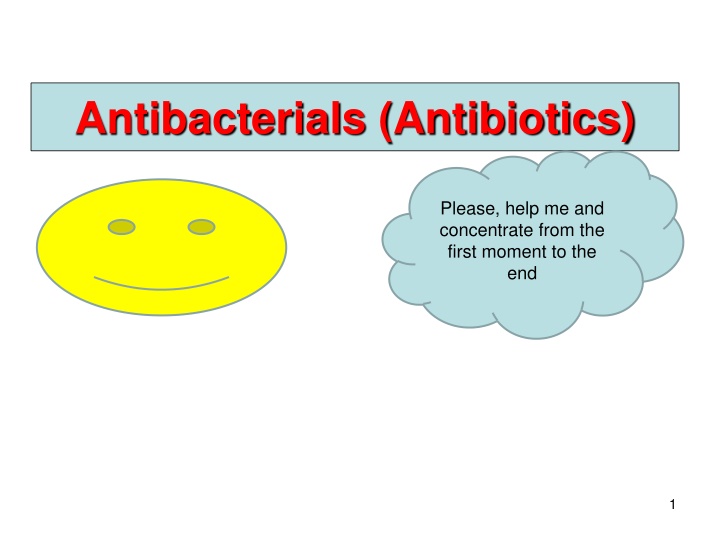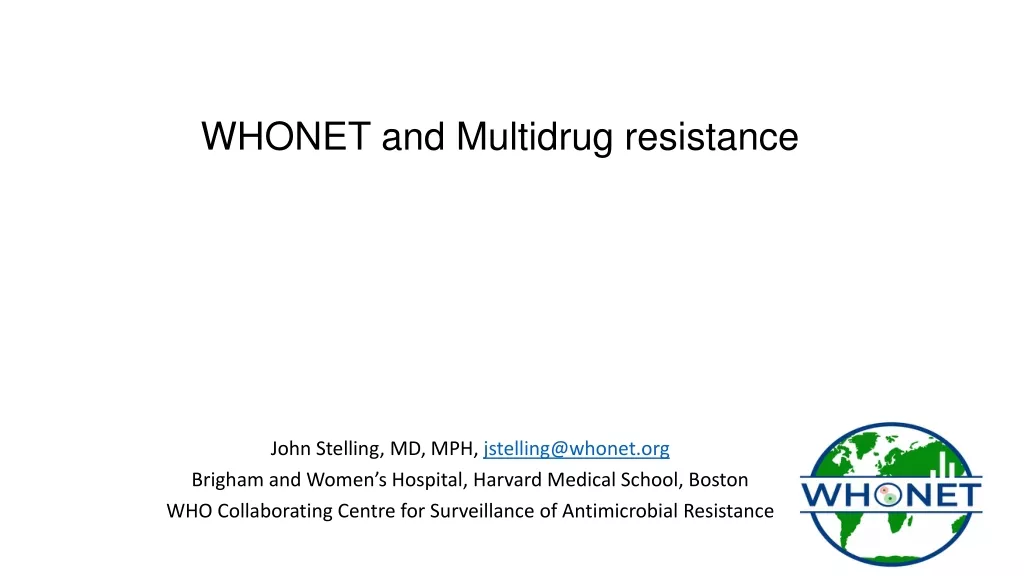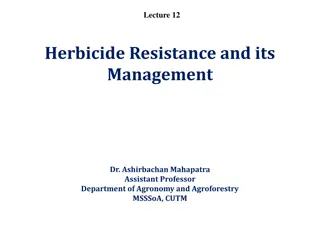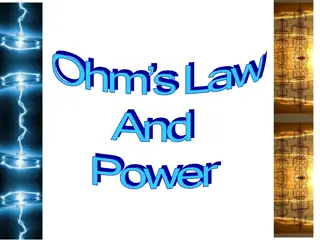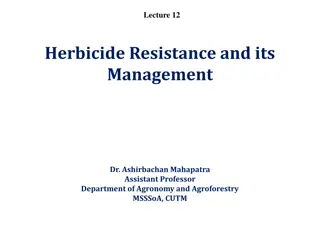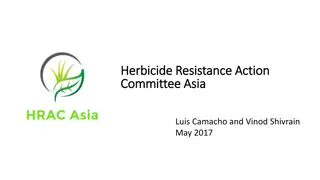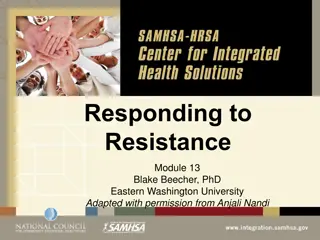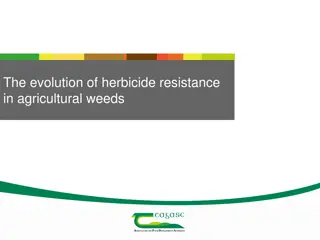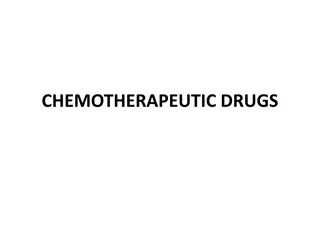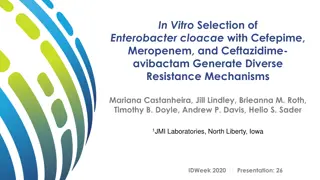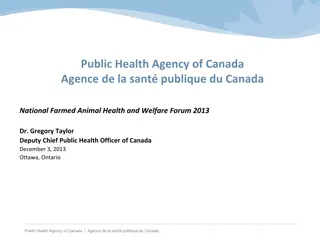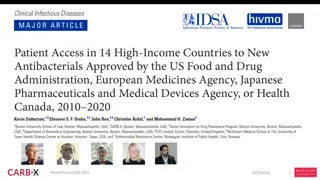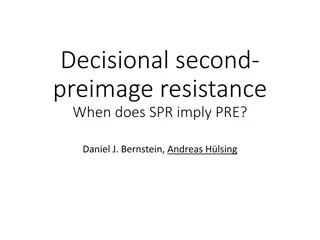Insights into Antibacterials: Mechanisms and Resistance
Antibiotics play a crucial role in combating microbial infections, but the emergence of antimicrobial resistance poses a significant challenge. Understanding the mechanisms by which antibacterial agents work, such as inhibiting cell wall synthesis, disrupting protein synthesis, and inhibiting metabolism or nucleic acid processes, is essential in developing effective treatment strategies. Bacteria can rapidly develop resistance to antibiotics, emphasizing the importance of prudent use and continuous research to tackle this global health issue.
Download Presentation

Please find below an Image/Link to download the presentation.
The content on the website is provided AS IS for your information and personal use only. It may not be sold, licensed, or shared on other websites without obtaining consent from the author.If you encounter any issues during the download, it is possible that the publisher has removed the file from their server.
You are allowed to download the files provided on this website for personal or commercial use, subject to the condition that they are used lawfully. All files are the property of their respective owners.
The content on the website is provided AS IS for your information and personal use only. It may not be sold, licensed, or shared on other websites without obtaining consent from the author.
E N D
Presentation Transcript
Antibacterials (Antibiotics) Please, help me and concentrate from the first moment to the end 1
Introduction Antibiotics are compounds (either natural or synthetic) that inhibit the growth and survival of microorganisms without serious toxicity to the host Antibiotics are amongst the most frequently prescribed medications today Antimicrobial resistance is becoming a serious issue, due to either misuse, overuse, or genetic changes in microorganisms
Bacteria & Antibacterials Antibacterial agents can be classified as being either Antibacterial agents can be classified as being either bacteriocidal kill bacteria) or kill bacteria) or bacteriostatic bacteriostatic (they disrupt the growth cycle) (they disrupt the growth cycle) Whilst Whilst bacteriocidal bacteriocidal is better, for some drugs is better, for some drugs (e.g. tetracycline) clinical dosage required to be clinical dosage required to be bacteriocidal bacteriocidal is too high, so it is considered to be considered to be bacteriostatic bacteriostatic Bacteria Bacteria rapidly develop resistance to a drug, rapidly develop resistance to a drug, often involving a change in the bacterium's biochemistry in the bacterium's biochemistry bacteriocidal (they (they (e.g. tetracycline) the is too high, so it is the often involving a change Bacteria are classified either as gram positive or gram negative 3
Mechanisms of Antibacterial Agents Principally, current antibacterial agents act by one of the following mechanisms: Inhibition of bacterial cell wall synthesis ( -lactams) (Penicillines) (Cephalosporines) Disruption of protein synthesis (Inhibitors of protein synthesis) (Macrolides, Tertacyclines, Aminoglycosides) Inhibition of cell metabolism (Antimetabolites) (Sulfonamides) (Pyrimidines) Inhibition of nucleic acid transcription / replication (Inhibit DNA replication) (topoisomerase II or Gyrase) (Quinolones) 4
Inhibitors of Bacterial Cell Wall Biosynthesis The -lactams Penicillins -lactamase inhibitors (special case!) Cephalosporins Monobactams 5
Inhibitors of Bacterial Cell Wall Biosynthesis The bacterial cell wall is significantly different in structure and function compared to the outer layer of mammalian cells The bacterial cell wall is chemically different from mammalian cells, and is therefore constructed by enzymes that often have no mammalian counterpart There are three distinct functions of the bacterial cell wall Providing a semi-permeable barrier that allows only "desirable" substances to pass Providing a sufficiently strong barrier so that the bacterial cell is protected from changes in osmotic pressure of its environment To prevent digestion by host enzymes 6
Inhibitors of Bacterial Cell Wall Biosynthesis Penicillins 7
Structure of -Lactam The name lactam is given to cyclic amide, cyclic ester called lactone Beta-lactam is a cyclic amide with four atoms in its ring N O H beta-lactam (azetidinone) This structure system found to be the feature of the structure of the penicillins and cephalosporins 8
Structure Activity Relationship cis-stereochemistry essential amide essential not essential, but usually present H H H N R S CH3 O free carboxylic acid essential CH3 N variable O CO2H -lactam essential Conclusions Amide and carboxylic acid are involved in binding Carboxylic acid binds as the carboxylate ion Mechanism of action involves the -lactam ring Activity related to -lactam ring strain (subject to stability factors) Bicyclic system increases -lactam ring strain Not much variation in structure is possible Variations are limited to the side chain (R) 9
Mechanism of Action of Penicillins Penicillins inhibit a bacterial enzyme called the transpeptidase enzyme which is involved in the synthesis of the bacterial cell wall The -lactam ring is involved in the mechanism of inhibition Penicillin becomes covalently linked to the enzyme s active site leading to irreversible inhibition O O O H N H N H N H H H H H H C C C S S S Me Me Me R R R Enz-Nu O C Nu-Enz N N HN Nu Me Me Me -H O O CO2H CO2H CO2H Enz H Covalent bond formed to transpeptidase enzyme Irreversible inhibition 10
Mechanism of Action of Penicillins All penicillins act on the same target enzyme (irrespective of Gram (+) or ( )) This enzyme (a trans-peptidase) is responsible for the cross-linking of the peptidoglycan that makes up the bacterial cell wall An incomplete cross-linked cell wall leads to a leaky cell and ultimately lysis NAM NAM NAM NAG NAG L-Ala NAM NAM NAM NAG NAG D-Glu L-Ala H3C O NAG NAG NAM NAM NAM NAM L-Lys L-Lys L-Lys D-Glu D-Glu D-Glu O NH L-Ala L-Ala L-Ala D-Ala D-Ala D-Ala O L-Lys H3C L-Lys L-Lys D-Glu D-Glu D-Glu D-Ala D-Ala D-Ala L-Lys L-Lys L-Lys D-Ala D-Ala D-Ala formation catalysed by trans-peptidase (which blocked by penicillins) 11
General SAR of Penicillins It was very soon realised that whilst penicillins were excellent antibacterial agents, some limitations existed For penicillin G, the following points were noted: 1. acid sensitive 2. sensitive to -lactamases 3. narrow spectrum of activity H H N H S CH3 O CH3 N O CO2H benzylpenicillin 12
The Acid Sensitivity of Penicillins The -lactam amide bond is the most unstable bond in penicillin, due to three main factors: ring strain; highly reactive -lactam carbonyl group; neighboring group participation. 1. Ring strain O O O H N H N H H H H Acid or enzyme H N H H C C C S S Me Me S Me R R R HO HO2C N HN Me Me N H2O Me O O CO2H CO2H CO2H H Penicilloic acide (inactive) 2. Highly reactive -lactam carbonyl (electrophilic centre) 13
The Acid Sensitivity of Penicillins 3)Acyl Side Chain - neighbouring group participation in the hydrolysis mechanism R H N N H R R C N S S S -H O O HN O N N O O O H Further reactions The metabolism of penicillin can, in part, be considered to be similar to the sequence shown above Introduction of an electron-withdrawing side chain group ("R") can limit the degree of neighbouring group participation and improve acid stability 14
Solutions to Acid Sensitivity Since the -lactam ring is essential for activity, nothing can be done about ring strain and the reactivity of the -lactam carbonyl However, several analogues of penicillin G have been prepared with electron withdrawing groups in the side chain H H N H Penicillin V (phenoxymethyl penicillin) is more acid stable because the PhOCH2 group reduces the electron density at the side chain carbonyl S O CH3 O CH3 N less electron rich, less nucleophilic O CO2H Unfortunately, penicillin V is still sensitive to -lactamases, and only has moderate activity Additional substitution on the side chain does produce useful compounds, especially if both groups are electron withdrawing: To conclude: the problem of acid sensitivity is solved by having an EWG on the acyl side chain 15
Problem 1 Solution to the Acid Sensitivity Conclusions The -lactam ring is essential for activity and must be retained Therefore, cannot tackle factors 1 and 2 Can only tackle factor 3 Strategy Vary the acyl side group (R) to make it electron withdrawing to decrease the nucleophilicity of the carbonyl oxygen H N H E.W.G. S C N O O Decreases nucleophilicity 16
Problem 1 Solution to the Acid Sensitivity Examples X H N H H N H PhO CH2 HC S S C C R N O N O electronegative oxygen O O Penicillin V (orally active) X = NH2, Cl, PhOCONH, Heterocycles, Better acid stability and orally active But sensitive to -lactamases Slightly less active than Penicillin G Allergy problems with some patients Very synthetic penicillins e.g. ampicillin, oxacillin successful semi- NH2 NH2 H H H N H H N H S S CH3 CH3 O O CH3 CH3 N N HO O O 17 CO2H CO2H ampicillin amoxycillin
Sensitivity of Penicillins to -Lactamases -Lactamases are enzymes present in all strains of penicillin resistant bacteria R R H N H H H H H H NH NH R S S S O CH3 O CH3 CH3 O CH3 N CH3 HN CH3 HN O O O OH O CO2H CO2H CO2H HO penicilloic acid -lactamase HO -lactamase -lactamase released as active enzyme 18
Problem 2 Improve Sensitivity to -Lactamases Strategy Block access of penicillin to active site of enzyme by introducing bulky groups to the side chain to act as steric shields Size of shield is crucial to inhibit reaction of penicillins with - lactamases but not with the target enzyme (transpeptidase) O Bulky group H N H H C S Me R N Me Enzyme O CO2H 19
Improving Sensitivity to -Lactamases The sensitivity of penicillins to -lactamases became a big issue in the 1960's with the emergence of S. aureus infections (80% were resistant to penicillins, with the majority of infections occurring in hospitals) Through the synthesis of analogues it was found that introduction of a bulky group on the side chain could limit sensitivity to -lactamases H N bulky group H H Importantly, do not want the group to be too large, otherwise the compounds loose antibacterial activity S CH3 O CH3 N O CO2H Examples of -lactamase resistant penicillins Significantly lower spectrum of activity, but is active against some Staph. bacteria Emergence of MRSA is a problem (& limits clinical usefulness) acid sensitive (no EWG???) Shifting the CH3O group to the para-position abolishes -lactamase resistance OCH3 H N H H S CH3 O CH3O CH3 N O CO2H methicillin 20
Improving Sensitivity to -Lactamases Examples - Methicillin (Beechams - 1960) O ortho groups important H N H H C MeO S Me N Me OMe O CO2H Methoxy groups block access to -lactamases but not to transpeptidases Active against some penicillin G resistant strains (e.g. Staphylococcus) Acid sensitive (no e-withdrawing group) and must be injected Poorer range of activity MRSA: Methicillin-resistant Staphylococcus aureus Inactive vs. Gram -ve bacteria 21
Improving Sensitivity to -Lactamases To overcome the problem of the acid sensitivity of methicillin, the solution is to introduce an EWG whilst maintaining some steric bulk R' Oxacillin (R = R' = H) R H N N H H Cloxacillin (R = Cl, R' = H) S O CH3 Dicloxacillin (R = R' = Cl) isoxazole (bulky & EWG) O CH3 N CH3 Flucloxacillin (R = Cl, R' = F) O CO2H These compounds are generally less potent than penicillin G against Gram (+) bacteria that do not produce -lactamases, but retain their potency against those bacteria that do produce -lactamases Because of the electron-withdrawing nature of the isoxazole ring, these compounds have improved acid stability, & can therefore be taken orally Typically used to treat S. aureus infections (e.g. septicemia) Not active against Gram ( ) bacteria 22
Spectrum of Activity of Penicillins Gram (-) Many penicillins show a rather narrow spectrum of activity, especially against Gram ( ) bacteria This is due to the lipopolysaccharide layer that Gram ( ) bacteria have Hydrophobic groups in side chain favor Gram (+) bacteria Hydrophilic groups on side chain increase activity against Gram ( ) (increase in activity is greatest if the polar group is - to the carbonyl group) 23
Problem 3 Improve The Range of Activity Results of varying R in Penicillins 1. R= hydrophobic results in high activity vs. Gram +ve bacteria and poor activity vs. Gram -ve bacteria 2. Increasing hydrophobicity has little effect on Gram +ve activity but lowers Gram -ve activity 3. Increasing hydrophilic character has little effect on Gram +ve activity but increases Gram -ve activity 4. Hydrophilic groups at the -position (e.g. NH2, OH, CO2H) increase activity vs Gram -ve bacteria H NH2 O H N HO C C H H S H N Me C H R O N Me O 24 O CO2H
Problem 3 Improve The Range of Activity Examples of Broad Spectrum Penicillins Class 1 - NH2at the -position Ampicillin andAmoxycillin (Beechams, 1964) H NH2 H NH2 HO C C H N H N C H H C O O O O Ampicillin (Penbritin) 2nd most used penicillin Amoxycillin (Amoxil) 25
Problem 3 Improve The Range of Activity Properties Active vs Gram +ve bacteria and Gram -ve bacteria which do not produce -lactamases Acid resistant and orally active Non toxic Sensitive to -lactamases Increased polarity due to extra amino group Poor absorption through the gut wall Disruption of gut flora leading to diarrhoea Inactive vs. Pseudomonas aeruginosa 26
Problem 3 Improve The Range of Activity Prodrugs ofAmpicillin (Leo Pharmaceuticals - 1969) O C H R = PIVAMPICILLIN NH2 CH2O CMe3 C O H N H H C TALAMPICILLIN O R = S Me O Me N O O CO2R C R = CH O O CH2Me Me BACAMPICILLIN Properties Increased cell membrane permeability Polar carboxylic acid group is masked by the ester Ester is metabolised in the body by esterases to give the free drug 27
Problem 3 Improve The Range of Activity Examples of Broad Spectrum Penicillins Class 2 - CO2H at the -position (carboxypenicillins) CO2R CH R = H CARBENICILLIN R = Ph CARFECILLIN H N C H H S O Me Me N O CO2H Carfecillin = prodrug for carbenicillin Active over a wider range of Gram -ve bacteria than ampicillin Active vs. Pseudomonas aeruginosa Resistant to most -lactamases Less active vs Gram +ve bacteria (note the hydrophilic group) Acid sensitive and must be injected Stereochemistry at the -position is important CO2H at the -position is ionised at blood pH 28
Problem 3 Improve The Range of Activity Examples of Broad Spectrum Penicillins Class 2 - CO2H at the -position (carboxypenicillins) CO2H H H H N S Me TICARCILLIN O S N Me O CO2H Administered by injection Identical antibacterial spectrum to carbenicillin Smaller doses required compared to carbenicillin More effective against P. aeruginosa Fewer side effects Can be administered with clavulanic acid 29
Problem 3 Improve The Range of Activity Examples of Broad Spectrum Penicillins Class 3 - Urea group at the -position (ureidopenicillins) O O Azlocillin HN N R2N NH O H H H N MeO2S Mezlocillin S N Me N O N Me Et N N Piperacillin O CO2H O O Administered by injection Generally more active than carboxypenicillins vs. streptococci and Haemophilus species Generally have similar activity vs Gram -ve aerobic rods Generally more active vs other Gram -ve bacteria Azlocillin is effective vs P. aeruginosa Piperacillin can be administered alongside tazobactam 30
Broad Spectrum Penicillins Orally active compounds (aminopenicillins) NH2 introduction of the amino group (electron withdrawing) makes it acid stable many Gram ( ) bacteria are susceptible susceptible to -lactamases (no bulky group) H H N H S CH3 O CH3 N O CO2H ampicillin To overcome the problem of sensitivity to -lactamases, ampicillin can be used in conjunction with other compounds: H OH no real antibacterial activity excellent irreversible inhibitor of -lactamases markedly enhances the potency of ampicillin when the two are used together O N O CO2H clavulanic acid O O H S CH3 Oxidation of the sulfur to a sulfonyl group greatly enhances the potency towards -lactamases CH3 N O 31 CO2H sulbactam
Broad Spectrum Penicillins Orally active compounds (aminopenicillins) The oral efficacy of ampicillin is relatively poor (only ~30 50% absorbed) due to the zwitterionic character (at physiological pH) This leads to G.I. problems (e.g. diarrhoea) associated with disruption to normal gut flora Amoxicillin has much higher oral absorption (~80%) & consequently causes less g.i. disturbances The problems with the absorption of ampicillin can be overcome by the use of ester derivatives (PRODRUG) NH2 H H N H NH3 S H H N H CH3 S O CH3 CH3 N O O O CH3 N O C2H5 O O O CO2 ampicillin H3C bacampicillin These types of compounds (e.g. bacampicillin) are very well absorbed (~95%) and are then hydrolysed by endogenous esterases 32
Summary of Penicillins EWG H H N H For improved acid stability: S CH3 (electron withdrawing group) O CH3 N O CO2H OCH3 To improve -lactamase resistance: H H N H S (steric bulk) CH3 O CH3O CH3 N O CO2H R H H N H Broad spectrum compounds: S CH3 O CH3 N O CO2H 33
Trade: Unasyn Generic: sultamicillin 34
Cephalosporins the first cephalosporin discovered (Cephalosporin C) had very poor antibiotic activity (about 1/1000th the activity of penicillin G) amide aminoadipidic side chain dihydrothiazine H N H H H H N H H2N S S CH3 O CO2H O N OAc CH3 N O O -lactam CO2H CO2H penicillin G cephalosporin C Cephalosporins (esp. 1st generation compounds) are generally not orally active They have similarly poor activity against Gram-(+) and Gram-( ) bacteria 36
Properties of Cephalosporin C H H H N S 1 H2N 7 8 6 5 2 3 H CO2H O 4 N O Me C O Disadvantages Polar due to the side chain - difficult to isolate and purify Low potency - limited to the treatment of urinary tract infections where it is concentrated in the urine Not absorbed orally Advantages Non toxic Lower risk of allergic reactions compared to penicillins More stable to acid conditions More stable to -lactamases Ratio of activity vs Gram -ve and Gram +ve bacteria is better O CO2H Conclusion Useful as a lead compound 37
Structure Activity Relationships H H H N S 1 R 7 8 6 5 2 3 O 4 N O Me C O O CO2H Similar to penicillins The -lactam ring is crucial to the mechanism The carboxylic acid at position 4 is important to binding The bicyclic system is important in increasing ring strain Stereochemistry is important The acetoxy substituent is important to the mechanism 38
Structure Activity Relationships Possible modifications 7-Acylamino side chain 3-Acetoxymethyl side chain Substitution at C-7 modifications allowed H N H H R S 7 O N X O CO2H H H H H S H2N H2N S CH3 N OAc CH3 N O O CO2H CO2H 6-APA 7-ACA 39
Structure Activity Relationships Despite the fact that cephalosporins are less-strained than penicillins, they are still quite reactive due to the double bond between C-3 & C-4 and the methyleneacetoxy group at C-3 H N H H R S O N X O CO2H If the double bond is moved to the 2,3 position, there is a significant loss in activity The nature of the C-3 substituent is clearly important for activity 40
Mode of Action of Cephalosporins Cephalosporins are believed to have the same mode of action to penicillins (i.e. they bind to the bacterial trans-peptidase enzyme that forms the cross- linked peptidoglycan layer) H N H H H N H H R S R S [AcOH] O O N O N O HO O CH2 O O CO2H CO2H trans-peptidase trans-peptidase As with penicillins, cephalosporins are susceptible to attack by - lactamases (note that some -lactamases seem to be more efficient at hydrolysing penicillins, whilst others are better at hydrolysing cephalosporins) Like penicillins, introduction of steric bulk in the near the sidechain amide of cephalosporins leads to -lactamase resistance Allergic reactions are less common with cephalosporins than penicillins Cephalosporins do cause a few mild side effects, including nausea, vomiting & diarrhoea (due to disruption of normal flora) 41
Mode of Action of Cephalosporins H H H N S R H H H N S R 7 -CH3CO2- O N O Me O C N O O O CO2H O CO2H Ser OH Ser Enzyme Enzyme The acetoxy group acts as a good leaving group and aids the mechanism 42
First Generation Cephalosporins These compounds are primarily active against Gram (+) cocci & limited Gram ( ) strains. N H N H H S Cephapirin For parenteral use only Resistant to Staph. -lactamases, but susceptible to many others De-activated by endogenous esterases Good substitute for methicillin S O N OAc O CO2H Cephapirin Cefazolin C-3 acetyl group replaced with thiadiazole (still good leaving group, but resistant to esterases) Longer half-life than cephapirin Causes less pain upon injection H N H H N S N O N S N N S CH3 O N N CO2H Cefazoline 43
First Generation Cephalosporins Orally active compounds Cephalexin (R = H) & Cefadroxil (R = OH) Note similarity with ampicillin & amoxycillin Replacement of C-3 acetate with H eliminates metabolic deactivation, but also reduces potency The "ampicillin" sidechain does not appear to alter spectrum of activity, but does improve g.i. absorption Can be administered both orally and I.M. Limited activity against Gram ( ) bacteria NH2 H N H H S O N H R O CO2H NH2 H N H H Cephradine Note the hydrogenated aromatic ring This results in the ring being -electron rich & planar, but not conjugated Has good acid stability Can be administered both orally and I.M. S O N H O CO2H 44
Second Generation Cephalosporins oxime OCH3 Cefuroxime Has a cis-oriented methoxyimino group in the C-7 side chain Results in significantly improved resistance to some -lactamases due to steric bulk (the trans-analogue is not resistant) N H N H H S O carbamoyl O N O NH2 O CO2H O Cefoxitin Has an -methoxy group at C-7 Increased steric bulk leads to significant stability against many -lactamases Improved activity against some anaerobic infections compared to other 2nd generation OMe H N H S S carbamoyl O N O NH2 O CO2H O Introduction of the carbamoyl group at C-3 results in intermediate metabolic stability (b/n OAc & thiazole) 45
Second Generation Cephalosporins Orally Active Compounds Cefaclor Introduction of Cl at C-3 improves acid stability, allowing for oral administration Also quite stable to metabolism Less active against Gram ( ) than most 2nd generation, but more active than 1st Replacement of S with CH2 leads to more potent and more chemically stable compound (or CH2) NH2 H N H H S O N Cl O CO2H Cefprozil Has a propenyl group at C-3, conjugated with the ring Although both trans- and cis-forms are active, the predominant trans-isomer is more potent against Gram ( ) bacteria Slightly more potent than cefaclor NH2 H N H H S O N HO CH3 O CO2H 46
Third Generation Cephalosporins These compounds generally less active against staphylococci than 1st generation, but are much more active than both 1st & 2nd generation compounds against a broader range of Gram ( ) They are particularly useful against nosocomial multidrug-resistant hospital acquired strains Structurally, these compounds are typified by heteroaromatic and oxime containing C-7 sidechains Cefotaxime (X = CH2OAc) Significant -lactamase resistance due to side chain Excellent Gram ( ) activity C-3 acetoxy group vulnerable to degradation For parenteral use only OCH3 N H N H H S N H2N O N S X O Ceftizoxime (X = H) C-3 substituent completely removed (gives better metabolic stability) Other properties similar to cefotaxime CO2H 47
Third Generation Cephalosporins Orally Active Compounds Orally Active Compounds Cefixime Cefixime The C-7 sidechain cis-oximino acidic group leads to b-lactamase resistance C-3 vinyl group is similar to that in cefprozil Has excellent oral bioavailability Activity against Gram ( ) bacteria is intermediate between 2nd & 3rd generation compounds Poorly active against staphylococci CO2H O N H N H H S N H2N O N S O CO2H CO2H Ceftibuten Ceftibuten Has a cis-ethylidinecarboxyl group at C-7, leading to enhanced b-lactamase resistance and improved oral bioavailibility No C-3 substituent, so more metabolic stability Mainly used for respiratory & ear infections H N H H S N H2N O N S H O CO2H 48
Fourth Generation Cephalosporins Generally these compounds have better broad spectrum activity Cefepime The C-7 substituent gives broader spectrum of activity and increased resistance to -lactamases Also has improved staphylococcus activity The quaternary N-methylpyrrolidine at C-3 appears to assist penetration into Gram ( ) bacteria OCH3 N H N H H S N H2N O N N S O CH3 CO2 (zwitterionic) Several "next generation" cephalosporins are under development 49
Summary of Cephalosporins Summary of Cephalosporins replacement with small group (e.g. OMe) improves resistance to -lactamases acetate has better activity but is metabolised H N H H R S compounds with X OAc (e.g. H or double bond) have improved oral bioavailability O X N O steric bulk (e.g. oxime) as well as aryl or heteroaryl gives rise to improved -lactamase resistance CO2H charged groups seem to enter Gram ( ) bacteria better 50
